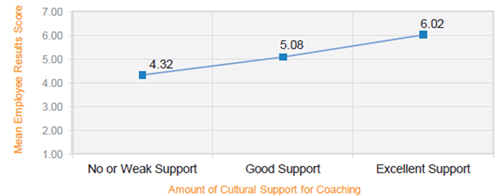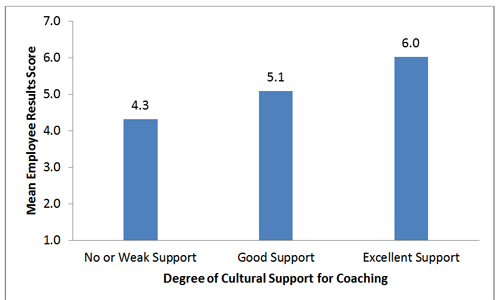Bersin & Associates senior analyst Stacia Sherman Garr demonstrates that organisations that coach deliver improved business and talent results.
The world of work is changing dramatically. People are highly connected, they operate on a global basis, and jobs are far more specialized. The confluence of these factors has contributed to a paradoxical imbalance in talent markets. Despite high levels of unemployment, employers are finding it difficult to find workers with the right skills. This imbalance is producing an incomparable talent scarcity that threatens economic growth around the world and is changing the way we approach performance management.
 "Because coaching keeps employees' skills competitive in the market, its perceived value can outweigh higher compensation offered by other companies."
"Because coaching keeps employees' skills competitive in the market, its perceived value can outweigh higher compensation offered by other companies."One of the biggest changes to performance management – and arguably one of the most effective employee retention strategies – is an increased focus on coaching. Because coaching keeps employees' skills competitive in the market, its perceived value can outweigh higher compensation offered by other companies. Further, it can accelerate the development of younger, less experienced workers. Coaching can also build loyalty by demonstrating that the organisation is willing to invest in its employees.
Coaching delivers several additional benefits. Bersin & Associates' research[1] shows that organisations with a coaching culture have much stronger employee engagement, employee productivity and customer satisfaction (see Figure 1).
Figure 1: Relationship between Coaching Cultures and Employee Results[2]


Source: Bersin & Associates, 2011.
In fact, our research found that organisations with strong coaching cultures delivered 13% stronger business results than those with weak coaching cultures.
Fostering a coaching culture
So what conditions foster a strong coaching culture versus a weak one? For coaching to work, organisations must ensure that senior leaders, managers and HR all support and reinforce a coaching culture. Senior leader support plays an especially important role. In fact, Bersin & Associates research found that organisations with senior leaders who "very frequently" coach employees had 21% better business and talent results than those who never coach. Senior leaders set the tone for a strong coaching organisation through three key behaviours – talking about the value of coaching, modelling coaching and holding others accountable for coaching.
HR also plays a critical role in educating managers about the benefits of coaching and how to do it effectively. Among the organisations highly effective at teaching these skills is Archer Daniels Midland Company, which created an eight-week 'Coaching to Win' programme. Leaders complete a combination of e-learning, self-assessments and a one-day workshop within the first few weeks. Following the workshop, the coaches complete additional weekly assignments, including focused learning activities and a cohort meeting where they receive coaching on how well they have coached.
Another organisation that has used coaching successfully is HCL Technologies in India. HCL provides coaching programs for senior and middle managers. This company also has developed coaching resources to support high-growth business units that had as many as 50 new employees join the firm per quarter. The coaching module is delivered via a train-the-trainer model in which business units train managers quickly and on a large scale to coach employees more effectively. HCL's L&D team developed templates, guidelines and workbooks to support coaches on an on-going basis. While the company does not attribute its results solely to manager coaching, it found that business units with manager coaching have enhanced employee engagement and team interactions.
The HCL example underscores the critical role HR plays in providing coaches with resources. Another organisation that demonstrates the importance of this role is the U.S. Internal Revenue Service (IRS). It developed an internal coaching and mentoring performance support website to extend classroom learning on the job and to improve the performance of employees. The website explains the IRS's coaching model, provides information about critical coaching skills, and includes tools and resources for employees to learn more about coaching. It also offers coaching videos that leaders may use to advance their skills as they prepare for conversations with their employees.
Providing tools alone with the occasional workshop will not ensure the success of a coaching culture, however. To succeed, coaching requires sustained support and modelling by senior leaders as well as organisational backing. Managers who are not recognized and rewarded for their coaching efforts will not take the time to do it. A poorly structured coaching programme that clashes with the culture is all but guaranteed to fail. An example of this is expecting sales people to coach each other without changing the incentive structure that rewards them solely for individual performance. Again, it is HR's responsibility to help senior leaders understand the conditions for sustaining an effective coaching culture, as well as the impact of it on their organisation's performance.
In short, creating an effective coaching culture requires hard work and the on-going support of senior leaders, managers and HR. However, as our research shows, savvy organisations increasingly are moving to a coaching and development model of performance management because it drives huge benefits via innovation, growth and the potential to deliver huge business impact.
[1] 'High-Impact Performance management: Part 1 – Designing a Strategy for Effectiveness'
[2] "Employee results" is an index comprised of employee engagement, employee performance and customer satisfaction.
Stacia Sherman Garr is senior analyst (talent Management) at Bersin & Associates, combines extensive research experience with her deep expertise in performance management, leadership development, and employee engagement in her analysis of talent management











